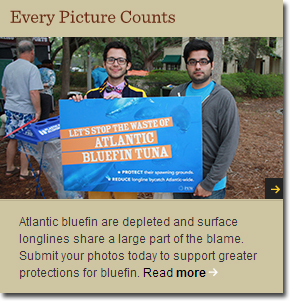U.S. policymakers know they need to limit the number of Atlantic bluefin tuna caught and killed by surface longlines which can stretch 40 miles with more than 750 baited hooks and float unattended for up to 18 hours. After all, the western Atlantic bluefin population is down 64 percent from its level in the 1970s, according to international scientists, due in part to this indiscriminate fishing gear. Yet an effective, comprehensive solution to this problem remains elusive.
On August 21, however, the National Oceanic and Atmospheric Administration, or NOAA, issued a proposed rule that could help protect depleted Atlantic bluefin from surface longlines. These regulations would be a step in the right direction, but we need more changes to effectively safeguard one of the most remarkable, yet depleted, fish in the sea.
Commercial fishermen use surface longlines primarily to target swordfish and yellowfin tuna, but too often they
So for western Atlantic bluefin, which use the Gulf of Mexico's waters as their only known spawning grounds, surface longlines are a serious problem. NOAA's proposed rule contains several changes to improve the management of Atlantic bluefin in the Gulf and Atlantic Ocean, with a focus on limiting the number of bluefin killed by the U.S. surface longline fleet. This includes provisions to:
- Establish a gear restriction area in the Gulf of Mexico for April and May where surface longlines would be prohibited, but highly selective alternative gears, such as green sticks and buoy gear, would be allowed.
- Establish another gear restriction area off Cape Hatteras, NC, from December through April that would be accessible only to fishermen using highly targeted alternative methods--or to operators of surface longline vessels that had demonstrated they could fish with minimal bluefin catch.
- Implement a new enforceable annual cap on the amount of bluefin caught on surface longlines in the Atlantic and Gulf, and establish a new individual bluefin quota allocation system, which would promote accountability.
- Add a requirement that all fishermen using longline vessels install and maintain video cameras and data recorders, report to the agency daily to better account for their catch, and record information on gear deployment and retrieval.
Several aspects of this proposed rule are promising for bluefin conservation. Under the new annual cap system, for example, once longline users exhausted their quota they would have to stop fishing unless they were able to purchase some of the quota belonging to another vessel operator. That would introduce a level of accountability for fishermen using surface longlines that has never existed--creating a real economic disincentive to catch bluefin with this gear.
Yet there are a number of places where the proposed rule should be stronger. While NOAA is proposing restrictions on the use of surface longline fishing in a portion of the northwestern Gulf of Mexico, that provision is insufficient. To fully protect bluefin, the area should encompass the entire Gulf of Mexico, so that it includes all known important breeding grounds, and the entire peak spawning season, March through May.
Also problematic is a provision that would take away a set amount of the bluefin quota from fishermen using targeted methods and give it to the surface longline fleet. This would be a major step backward in the protection of Atlantic bluefin tuna and the goal of promoting sustainable fishing. As drafted, this quota reallocation would seriously undercut current efforts to promote the use of new, more selective fishing gear technologies to catch swordfish and yellowfin tuna--many of which have been developed cooperatively by scientists and enterprising fishermen in the Gulf.
From my days working at NOAA, I know how hard it is to strike the right balance in a proposed rule. But taking quota from other fishing sectors and giving it to vessel operators using wasteful surface longlines would be neither fair nor balanced. NOAA's leadership must not let that provision move forward.
Support HuffPost
Our 2024 Coverage Needs You
Your Loyalty Means The World To Us
At HuffPost, we believe that everyone needs high-quality journalism, but we understand that not everyone can afford to pay for expensive news subscriptions. That is why we are committed to providing deeply reported, carefully fact-checked news that is freely accessible to everyone.
Whether you come to HuffPost for updates on the 2024 presidential race, hard-hitting investigations into critical issues facing our country today, or trending stories that make you laugh, we appreciate you. The truth is, news costs money to produce, and we are proud that we have never put our stories behind an expensive paywall.
Would you join us to help keep our stories free for all? Your contribution of as little as $2 will go a long way.
Can't afford to donate? Support HuffPost by creating a free account and log in while you read.
As Americans head to the polls in 2024, the very future of our country is at stake. At HuffPost, we believe that a free press is critical to creating well-informed voters. That's why our journalism is free for everyone, even though other newsrooms retreat behind expensive paywalls.
Our journalists will continue to cover the twists and turns during this historic presidential election. With your help, we'll bring you hard-hitting investigations, well-researched analysis and timely takes you can't find elsewhere. Reporting in this current political climate is a responsibility we do not take lightly, and we thank you for your support.
Contribute as little as $2 to keep our news free for all.
Can't afford to donate? Support HuffPost by creating a free account and log in while you read.
Dear HuffPost Reader
Thank you for your past contribution to HuffPost. We are sincerely grateful for readers like you who help us ensure that we can keep our journalism free for everyone.
The stakes are high this year, and our 2024 coverage could use continued support. Would you consider becoming a regular HuffPost contributor?
Dear HuffPost Reader
Thank you for your past contribution to HuffPost. We are sincerely grateful for readers like you who help us ensure that we can keep our journalism free for everyone.
The stakes are high this year, and our 2024 coverage could use continued support. If circumstances have changed since you last contributed, we hope you’ll consider contributing to HuffPost once more.
Already contributed? Log in to hide these messages.

